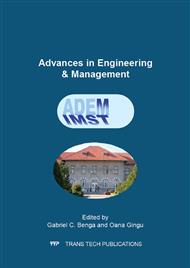p.91
p.97
p.103
p.109
p.114
p.118
p.127
p.136
p.140
The Tribological Behavior of some Steel Samples Prepared by Powder Metallurgy Sintered in Microwave Field
Abstract:
The objective of this research is to observe the influence of the sintering temperature on the wear testing for some steel samples elaborated by powder metallurgy technology. For obtaining the steels there were used iron powders and graphite powders. The powders were homogenized in a high energy ball mill Pulverisette 6, cold compacted and then sintered using a Muegge type microwave heating installation. The influence of the sintering technique on the samples’ wear behavior is studied using both a tribometer and a profilometer.
Info:
Periodical:
Pages:
114-117
Citation:
Online since:
June 2015
Authors:
Keywords:
Permissions:
Share:
Citation:


